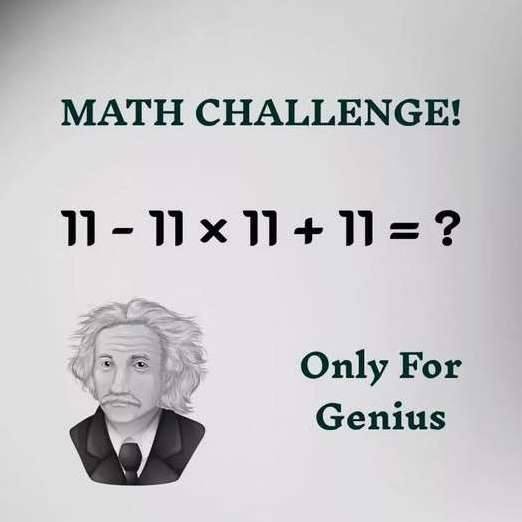Think you’ve got what it takes to crack a seemingly simple math puzzle that’s left countless people second-guessing their answers? This brain teaser is making the rounds online and sparking heated debates over what should be a straightforward equation. At first glance, it looks like elementary-level math—but don’t let appearances fool you.

Only those with a sharp grasp of order of operations will be able to get it right on the first try. The equation in question is: 11 – 11 × 11 + 11 = ? Looks harmless enough, right? Just a bit of subtraction, multiplication, and addition, nothing too advanced. But that’s exactly what makes it tricky. Most people jump into solving it from left to right, forgetting one of the most important rules in arithmetic. Before we dive into solving it, ask yourself—can you do this in your head in less than 20 seconds? No calculators, no Googling, just good old-fashioned brainpower. If you’re feeling confident, give it a shot before scrolling down to check the answer.
If not, don’t worry—most people get tripped up by this one. The key to solving this puzzle lies in remembering a concept taught in early math classes: the order of operations. In the United States, this is often remembered using the acronym PEMDAS (Parentheses, Exponents, Multiplication and Division, Addition and Subtraction). In other parts of the world, it’s known as BODMAS, which stands for Brackets, Orders, Division and Multiplication, Addition and Subtraction. Regardless of what acronym you use, the core idea remains the same: not all operations in math are treated equally, and there’s a specific sequence in which they must be performed to get the correct result. In our case, let’s apply the rule step-by-step. The original equation is 11 – 11 × 11 + 11.
According to the order of operations, multiplication comes before addition or subtraction. That means your first move is to calculate 11 × 11, which equals 121. Now the equation becomes 11 – 121 + 11. Next, you handle the subtraction and addition from left to right. Start with 11 – 121, which gives you -110. Then add 11, and you’re left with -99.
So the final answer is -99. Despite how straightforward it looks, this puzzle tripped up a lot of people online because they either forgot the proper order or tackled the problem from left to right without pausing to apply the multiplication first. It’s a classic example of how deceptively easy equations can stump even adults when they rely more on instinct than proper math rules. Many people guessed answers ranging from 121 to 0 to -11, but only a few landed on the correct solution of -99. It’s not necessarily a test of intelligence, but rather of attention to detail and remembering foundational math principles. These types of brain teasers are great not only for keeping your mind sharp but also for reminding us how important it is to go back to the basics. In an age where calculators are always within reach and apps can solve equations with a quick photo, it’s easy to lose touch with the mental math skills we once practiced in school. Challenges like this offer a fun way to refresh those skills and test how well you can think under pressure. So the next time you see a simple math problem like this one floating around online, take a second to slow down and think before diving in. It might just be trickier than it looks. Whether you nailed it in 20 seconds or found yourself second-guessing, puzzles like this are a great reminder that math isn’t just about numbers—it’s about logic, discipline, and keeping your brain engaged. And who knows, with enough practice, you might just become the person who always gets these right on the first try.





